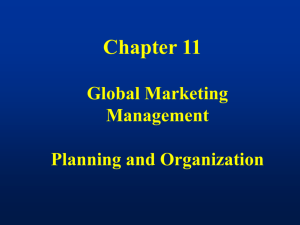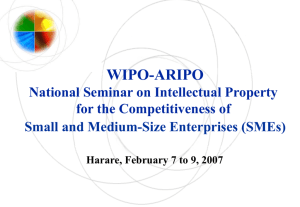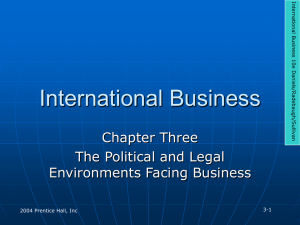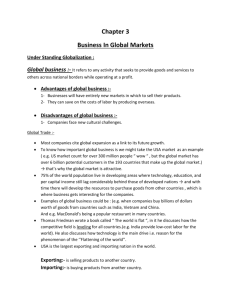Document
advertisement
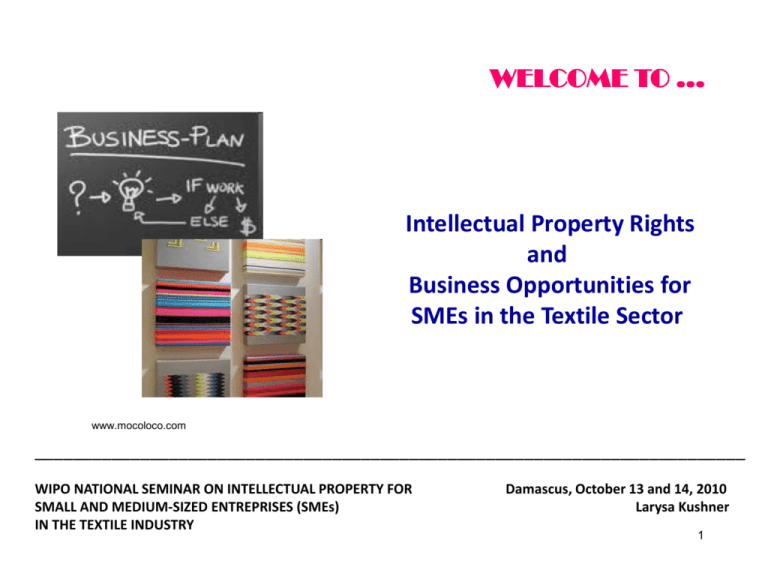
WELCOME TO ... Intellectual Property Rights and Business Opportunities for SMEs in the Textile Sector www.mocoloco.com __________________________________________________________________________ WIPO NATIONAL SEMINAR ON INTELLECTUAL PROPERTY FOR SMALL AND MEDIUM-SIZED ENTREPRISES (SMEs) IN THE TEXTILE INDUSTRY Damascus, October 13 and 14, 2010 Larysa Kushner 1 Overview 1. How can you generate income from your creations protected by IP? 2. Direct Use 3. Selling and Licensing 4. Franchising 5. Merchandising 6. Joint ventures and strategic alliances 7. New business models 1. How can you generate income from your creations protected by IP? IP as a business asset of your company • The crucial importance of the IP protection: – Transformation (even though for a limited time) of the intangibles that add value and differentiate a product into the proprietary rights = IP rights • The IP system provides exclusivity over the exploitation of innovative products and services, creative designs and business identifiers – to be acknowledged as an owner and prevent anyone else from using them – to exploit the their potential to maximum Exploiting IP Assets • Direct Use: Core to the competitiveness of the product or service • Indirect Use: – Sale, license, franchise or merchandise – Joint ventures and strategic alliances • Other possibilities: Defensive patenting, publication • Finance 2. Direct Use Direct commercialization of the IP assetrs by yourself Individual Exploitation to maintain the competiveness of the product • Make/produce copies of the products and sell them • Reproduce the works on different types of products • Exhibit the works in craft exhibitions, fairs, online catalogs, etc. • Enforce your IPRs against infringers Advantages: direct quality and exploitation control Disadvantages: high costs and risks Case Study: Burqini From SmartStart Project of Australian IP Office • Aheda Zanetti, originally from Lebanon, is a Australian Designer and Entrepreneur who designed in 2003 an innovative solution to this age-old problem for women of Muslim or Arab descent who wished to preserve their modesty when enjoying sport and swimming: Burqini • Design registration and later Trade Mark registration for the logo and company name • The Burqini is now distributed worldwide through online sales and key retailers in Bahrain and the Netherlands, along with a stand-alone store in Sydney’s Punchbowl From http://www.ahiida.com/ Indirect Commercialization of IP Assets • Mediate exploitation of IP Assets by third parties based on contractual agreements with the IP owner • Advantages: – Low investment / Low risks – Potentially high return • Drawback: Lack of control – Special attention to contracting Indirect Exploitation by the third parties Concerning: • All (registered and not registered) IPRs: trade marks, patents, industrial designs, copyright, know-how • Part of IPR (type of right) • Combination of IPRs Can be in a form of: • Assignment of the IPRs to a third party vs • License of the IPRs to a third party 3. Assignment and Licensing Why should business consider … Licensing IP... Selling (Assigning) IP Grant of a right to use the IPRs to a third party under contractually agreed conditions (// lease): possibility to limit Transfer of the ownership of the IPRs (//sale) Market; Geography; Time; Specific Application; Grant of Rights Usage Loss of all future income-earning potential Direct way to increase the value and benefits of your IPRs: Can generate lucrative fees and royalties New markets: Allows business to enter into new product categories or in new geographical areas in a relatively risk-free and cost-effective way Marketing tool: Increases the business’ exposure and recognition Buyer becomes a new owner of all assigned IPRs If no alternative If adequate price If no interest for further commercialisations Licensing that might be of interest for your business might concern... • Strategic, core technology or patents • Non-core or “mature” technology and patens, products • Struggling businesses or products (new or mature) • Technology that can be applied to other markets Trademrks, designs, copyright, know-how, any combination of them • Services 13 Why to license … For the Licensor For the Licensee •Earn revenue •Lower costs •Strengthening relations with partners in the value chain •Starting a new business •Capital saving • Access to new technologies and know how •Expanding an existing business (extending your territory or the nature of business) • Possibility of creating innovative products •Access to markets • Manufacture standardized product •Turning infringer/competitor into a partner •Create standard • Settle infringement dispute Why NOT to license … For the Licensee For the Licensee • Create competitor • Royalties add cost • Bad choice of licensee could damage reputation • Secrecy requirements • Loose control of proprietary information • Administrative burdens - audits, reports etc • May be obliged to grant back improvements Case Study: Non exclusive licensing strategy From Case Studies Collection of WIPO SMEs Division Intelligent Textiles: patents, trade secrets • Innovative process of weaving complex electrical circuits into conductive fabrics such as cotton, wool and polyester was developed by two academics • Selling back the patent rights from the university, establishing a company, registering trade mark • Operating out of a two-room studio near London with limited staff • Use of technology in the jackets’ sleeve to control an MP3 player; in an easy chair that reclines at the squeeze of the armrest; and in foot-warming insoles for shoes and ski boots • Selling the technology through consulting contracts to a range of industries in Europe and the United States • Outsourcing what they do not have time to do themselves Case Studies: Non exclusive licensing strategy Examples of licensing Patents • Patented technology for the treatment of “stone washed” denim jeans of Novozymes, a Danish, biotech company specializing in enzymes and microorganisms • Novozymes’ technology for improving production methods and fabric finishing has been licensed worldwide Trademarks • Certification marks Treatment of cotton without cellulase Novozymes with cellulase Case Studies: Non exclusive licensing strategy Copyright Su Embroidery Studio http://www.suembroidery.com/ Embroidery Stock design: • Library of designs for commercial embroidery companies to sew on garments for sale • Download online • License agreements to use design Dakota Collectibles Embroidery Design Center http://www.dakotacollectibles.com • Allows embroiders to choose according to their preferences and project needs Jammin' Sm. Jumper People Case Study: Combined licensing strategy Industrial Design: BABY AND CHILDREN The small French enterprise BABY AND CHILDREN designed and produced a baby hammock for the bathroom. • Obtaining design registration on the hammock • Commercialization of the product in over ten countries in three different continents directly and by granting licenses Case Study: Exclusive Strategic Licensing Based on the materials of Julian Nolan • Avionics system – mature product – commitment to support customers • high cost to change – still profitable, but none core • Licensed to main customer – Deal structure – NPV increased, GNPV – Regain strategic focus • Win-Win result Licensing Consider licensing: • You are an artist/designer/inventor and don’t want to be involved in manufacturing • You don’t have capacity to produce more items • You don’t want to produce elsewhere (in Syria/abroad) • You don’t have capacity to distribute elsewhere • You want to benefit from a better reputation of a partner How to develop a proper licensing strategy ? 1. Protect your IP rights 2. Find right licensee 3. Assess foreign markets 4. Tailor scope of license to actual needs of licensee 5. Preserve control over the commercial use of your works 6. Negotiate fair compensation 7. Draft a solid license agreement 8. Management of licenses Key elements of a licensing agreement • Licensor: grant of the right to use specified IPRs by licensee • Licensee: payment of royalties to the licensor • Scope of the license: – Exclusivity – Scope of use (manufacture / distribution) – Territory – Right to sublicense • Representations and warranties – Validity of the IPRs (best knowledge?) – Indemnification (limitation of) – Enforcement of the IPRs against third party infringers – Liability of the licensor ? – Standing to sue of the (exclusive) licensee ? Key elements of a licensing agreement • Control over licensee’s accounting methods (for purpose of checking the amount of the royalties) • Control over licensee’s use of the IPRs with respect to: – Quality of the products sold under licensor’s IPRs – Prohibition to misappropriate licensor’s IPRs • Confidentiality • Term of the agreement: – early termination / termination for – breach of the agreement / post termination obligations • Governing law • Jurisdiction / dispute settlement (mediation – arbitration under the WIPO rules) Licensing You don’t get the deal you deserve, you get the deal you negotiate www.lapiana.com 4. Franchising Franchising Specialized license where the franchisee is allowed by the franchisor in return for a fee to use a particular business model and is licensed a bundle of IP rights (TM, service marks, patents, trade secrets, copyrighted works…) and supported by training, technical support and mentoring • All franchisees are licensees but not all licensees are franchisees Franchising • Franchising vs licensing – Licensing of IPRs is an element of franchising – Licensing of IPRs is the means to reach the end • Goals of franchising – For the franchisor: geographically expand its business without taking financial risks – For the franchisee: benefit from the brand, experience and know-how of the franchisor Why … Why enter into a Franchise? Why not enter into a Franchise? • Lower risk of failure • All IPR owned by the Franchisor • Recognizable image • Payment of fees • On going support • Easier to obtain financing • Obliged to follow the business model • Benefit from franchisors R&D • Depend on the success of the Franchisor Key elements of franchise agreement • Franchisor: – – – – Making available its commercial concept (including IPRs) Instruction / assistance to the franchisee (services) Supply of products to the franchisee Exclusivity • Franchisee: – Payment of royalties – Following the guidelines of the franchisor – Promotion + Non-Disclosure Document: Confidentiality agreement contract between franchisor and franchisee to keep the information secret 5. Merchandising Merchandising • Commercial exploitation of a name, symbol or distinctive sign which has acquired a certain brand recognition in a specific field(s) for the purpose of selling goods or services in other fields • Often distinctive signs or characters themselves derive from television, film, toys, books, comics, and computer games Merchandising • Merchandising vs licensing – Merchandising is based on licensing • Goals of merchandising – For the merchandisor: expand its business to other lines of products / services without taking financial risks – For the merchandisee: benefit from the brand recognition of the merchandisor’s products / services Merchandising Examples: Taj Mahal, India Collection of Licensed Products embroidery design Licensed by Warner Bros. Consumer Products, Inc Picasso Elvis '68 Fabric by Cranston Village Licensed by Elvis Presley Enterprises Case Study: Mary Engelbreit From WIPO SMEs Division Case Studies Collection • Mary Engelbreit is known throughout the world for her colorful and intricate designs, and has become a pioneer for art licensing • Beginning: "drawing to order" for free-lance clients • Went to New York illustrating greeting cards • Several well-known card companies bought her designs, and sales were brisk into a million-dollar-a-year business. • Decision to license her cards to Sunrise Publications to free up more time for her art and to grow her business in other areas Case Study: Mary Engelbreit • Other companies were anxious to merchandise Mary's distinctive artwork on a wide range of products including calendars, T-shirts, mugs, gift books, rubber stamps, ceramic figurines and more www.maryengelbreit.com Case Study: Mary Engelbreit “A Day At The Beach” new collection of fabric designs • Mary Engelbreit Studios now has contracts with dozens of manufacturers who have produced more than 6,500 products in all. • Mary takes extreme care in choosing only the best companies to work with and goes to great lengths to make certain that her artwork is reproduced as faithfully to her original work as possible 6. Joint ventures and strategic alliances Case Study: Gustavo De Negri & Za.Ma • A small Italian company established in San Leucio in 1998 as a continuation of a long family tradition • Specialization on a exclusiv tailor-made silk fabrics, produced for the business to business sector • Constant self-renewal by creating new fabric designs Strategic alliances • with Milanese loom maker to incorporate the improvements in their new machines and with local university researchers to develop new techniques for finishing fabrics to gain technical innovation in the mill’s mechanical, chemical and finishing processes • with three other renowned silk textile makers from the district to market silk fabrics from San Leucio – Foundation of a consortium, – Registration and management of San Leucio Textile Silk Quality collective trademark Case Study: Heng Yuan Xiang Group (HYX) HYX was founded in 1927 till 1987 was a small wool store Shanghai • Creation of an eye-catching trademark and development of a successful branding strategy • Continuous R&D and promotion of the brand Strategic Alliances • with a textile factory that had the necessary assets for production – equipment, factories and capital • By 2010 with over seventy factories that help to manufacture its products • with thousands of franchisee ( 5,000 franchise stores) to sell its products in more than seventy categories via a comprehensive franchise system 6. New business models in textile sector New business models in textile sector • The computer-implemented, software-based business models – supply of a limited quantity of fashion products based on stealth and speed – Trademarks, copyright and trade secrets as core elements to protect such competitive advantage Case Study: ZARA • Spanish retail chain ZARA, uses a proprietary information technology (IT) system to shorten their production cycle Entire process takes 30 days (most competitors take from 4-12 months) • Electronic communication and management system ensures quick reaction on new trends and fabrics to develop new designs • Automated cut facility and a high-tech distribution system ensures the finished items are shipped and arrive in stores within 48 hours Conclusions • Protect your IP • Choose the best protection • All forms of IPRs can be used in combination for the best effect • In light of the recourses and market opportunities choose the right strategy to benefit from the IP • Even if you can’t or don’t want to use your IPRs yourself…Bear in mind that third parties may want to use them ! Thank you for your attention! Any Question? WIPO’s website for SMEs : www.wipo.int/sme Contact address: larysa.kushner@ehu.lt
